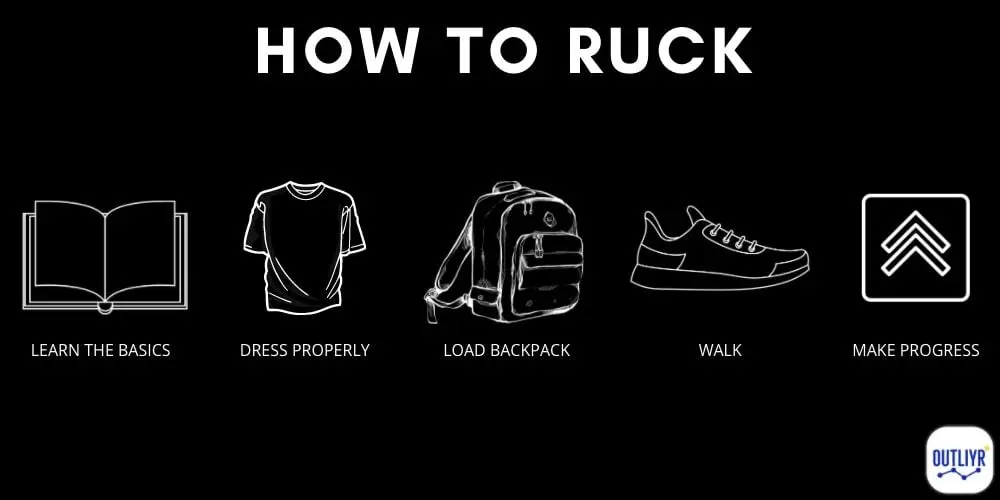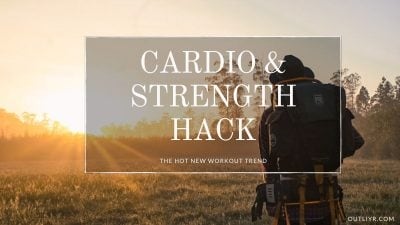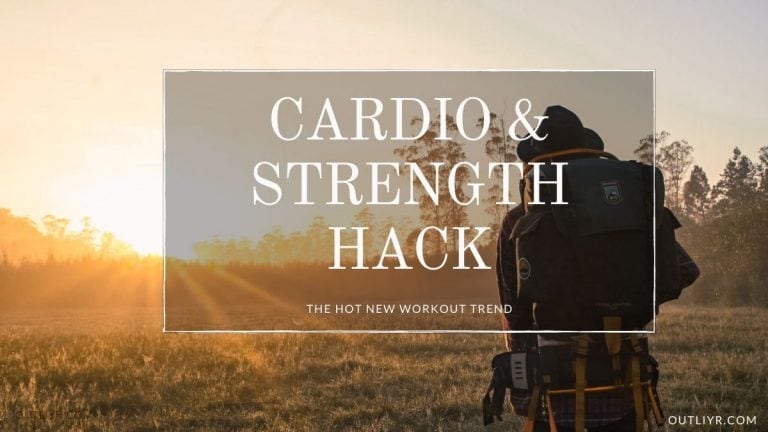I detest cardio. All forms of it.
But I never had much choice.
Trigger-happy coaches, especially in Football and Rugby, happily doled out cardio-based punishments:
- Made a wrong step: 3 laps
- Got the play wrong: 5 gassers
- Late to practice: 50 up-downs
- Over or under communicated: 25 burpees
- Lost the game: 10 suicides
I got into peak shape. Able to thrive in any situation. But it wasn’t fun. Post-college I wanted the strength, endurance, and injury-prevention benefits without dedicating my day to long soul-crushing workouts.
As my friends pointed out, I didn’t have to. My answer hid in plain sight. Without thinking anything of it, I’ve regularly done something for nearly a decade that’s revolutionized my health and fitness.
Rucking is my favorite easy workout modality, building a strong aerobic cardiovascular base without running, and powerful strength without lifting. Click To TweetThis post is the ultimate guide to rucking for beginners that want to transform their body. To build muscle, lose weight, and get healthy. Any time, anywhere, without a multi-thousand dollar garage of gear.
What is Rucking?
Rucking is simply walking with an extra heavy backpack. Modern rucking began with soldiers. Since they carry extensive gear, it’s the foundation of military training around the world. The military calls these heavy-duty backpacks “rucks”. “Rucking” is the activity of lugging them around. For soldiers and civilians alike, rucking is a difficult and powerful workout.
Here’s why.
Rucking is a compound movement that works the entire body in an integrated way. Leading to adaptations and functional fitness gains that carry over to everyday life. Additionally, rucking reduces injury risk. A single injury can derail months of progress, so rucking bulletproofs you against the biggest pitfall of typical exercise routines.
Walking with a heavy load taxes muscles and connective tissue (tendons and ligaments) throughout the body. Leading to increased strength without the need for a gym.
Rucking is best described as:
- Strength training for those that hate the gym
- Endurance training for those that hate running
- Integration training for those that hate sport-specific fieldwork
Greek soldiers rucked, Spartans rucked, Romans rucked. Today, elite military units like the Navy SEALs, Green Berets, Delta Force ruck up to 50 miles over rough terrain. All while carrying 45-pound rucksacks.
Then you have the unofficial ruckers. Those that carry loads over long distances throughout history. Hunters transporting a kill, farmers carrying crops, villagers fetching water from streams.
Mastering rucking comes with unique advantages.
19 Benefits of Rucking

Few forms of exercise offer a similarly impressive cost-to-benefit ratio of rucking. For a diverse crowd:
- Beginners or advanced
- Seniors or children
- The weak or strong
- The rich or poor
Virtually everyone can use it to get fit and transform their bodies.
Rucking is functional fitness for the modern survivalist Click To TweetProgress shows quickly. Here are some of the top rucking benefits I’ve discovered from a decade of practice.
Cheap
Gym memberships can cost $100-$250 per month, depending on where you live. Even a day pass can range between $10-40. You can start rucking for free with your current backpack and a rock. Then, when you’ve seen the benefit and are ready to commit, you can upgrade as I did.
I paid $275 for the top-of-the-line GORUCK GR2 (they sell cheaper models) which doubles as both my everyday backpack and the perfect rucksack. Within three months of replacing my gym, it more than paid for itself. I also use it as a portable gym. Adding or removing weight to alter my resistance for bodyweight and calisthenics workouts.
Simple
Load weight into your backpack. Throw it over your shoulder. Put shoes on. Start walking.
Rucking doesn’t require thousands of repetitions of perfect form with the highly refined eye of a specialist to master.
As you gain experience you can add on additional movements and intra-ruck workouts. But it’s only slightly more complicated than walking.
This is how I’ll introduce strength training to my eventual kids.
Anyone can start
The learning curve is virtually non-existent, making it easily incorporated by people at any level of physical fitness or skill. Beginners. The elderly. Those recovering from injuries.
Like golf, you can start rucking young and continue into old age.
Unlike some simple repetitive movements (like running), rucking doesn’t carry a high injury risk.
You can start and quickly reap the benefits. I often find myself recommending it to anyone that wants to get fit without serious time commitments. To get more out of their typical commute or other daily walks.
Adjustable difficulty
Increasing the difficulty of a session is as easy as loading more into your pack.
You can add metal plates for the greatest comfort. But sometimes you get out on the trail and wish you brought more. Some other things I add to increase weight:
- Rocks
- Water
- Bags of sand
- Groceries
If it’s too much or you get tired, you can easily remove load. For the newbies, I suggest using rocks you find. That way you aren’t ditching $30-$60 metal plates should you need to lighten your pack.
Anywhere, Anytime
You only need a backpack and weight.
Making rucking an easy form of exercise to fit into any routine. You can use it to augment your existing training, or as a standalone workout.
I personally use my 40L pack as my primary piece of luggage. Doubling as both a carrier for my belongings and the only equipment I need (but I still bring portable fitness gear to further enhance my workouts). Perfect for travel, but also everyday use.
I can add a ruck to my morning body fat-burning walk. Or take meetings while rucking. Or even get a workout in while exploring.
Exploring new places
Nothing helps you learn new lands like transportation on foot.
Whether getting your bearings in a new city, immersing yourself in a new culture, or just meeting neighbors.
Walking provides a more intimate and memorable experience. Add sweat to that, and you’re killing two birds with one stone.
When I backpacked Asia and Europe, I carried just a single 40L backpack. I’d unload my clothing in my room, and then explore with my rucksack. Fully equipped with emergency first aid gear and plenty of room for souvenirs.
Natural disaster emergency preparation
The human body is perfectly engineered to easily move long distances over long periods.
Only occasionally would our ancestors move at high speed (running or sprinting) to hunt or avoid predators.
“Although bipedal gaits include walking and running, running is generally considered to have played no major role in human evolution because humans, like apes, are poor sprinters compared to most quadrupeds.”
I grew up on a mountain with off-the-charts fire danger. Always between code orange and red. Should something go wrong, at the drop of a hat I might need to walk 12+ miles over to San Francisco. That with my most prized possessions on my back.
But no matter your location, emergency situations can arise which demand you rise to the occasion. Rucking prepares you for the worst case.
Less damaging than running
Though similar in many regards, running places the body under far more stress than rucking. Let’s consider the gravitational force of different types of movement:
- Walking: 2.7 times bodyweight
- Rucking: 3.2 times bodyweight
- Running: 8 times bodyweight
Every running stride puts your knees, ankles, joints, and entire body under force equivalent to eight times your bodyweight. At my 200 pounds, those forces translate to:
- Walking: 540 pounds
- Rucking: 640 pounds
- Running: 1,600 pounds
Which explains in part, according to a 1992 study, the prevalence of recurring running where 20 to 70% require medical consultation or medical treatment.
Why run when you can get similar benefits from easier training?
Burns 3x more calories than walking (similar to running)
Energy expenditure and calorie burn (partially) determine weight loss.
Runners often pound the pavement to justify eat-anything-in-sight binges in the name of recovery.
Walking and running are fairly close in the terms of calorie burn. Depending on your size and weight, an overweight individual walking at a fast clip can burn up to 723 calories per hour. Those numbers likely don’t apply to you (unless you weigh 305 pounds and walk at 4.5 miles per hour).
That same individual rucking for one hour with a 45-pound pack burns 1,153 calories (according to this calculator). 1153/723 equals 59 percent more calories burned from rucking compared to walking.
Other estimates suggest that rucking can increase calorie burn by 40-60 percent, making it a great alternative to walking or running for weight loss.
Cardiorespiratory and VO2 max benefits equal to running
Running’s cardiovascular benefits come through several mechanisms.
Chief among them: duration, intensity, and the resulting heart rate elevation.
Walking builds cardiovascular fitness. As does running.
Research on walking with weight shows that it significantly increases heart rate. From Dr. Doug McGuff’s work in Body by Science, we know that you can build your aerobic base and cardiovascular health from increasing workout intensity and without running.
The cardiorespiratory and VO2 max gains from rucking seem to carry over to other endurance sports too.
Builds strength
Anyone that’s rucked consistently can attest to the soreness and strength it builds.
This is due to the recruitment of many of the body’s muscles, and compensatory adaptations that the joints, ligaments, tendons, and stabilizers go through. Rucking strengthens your:
- Feet
- Ankles
- Calves
- Quads
- Hamstrings
- Hips
- Core
- Abs
- Obliques
- Back
- Delts
- Traps
Best of all, it is a compound movement that activates many of the body’s systems simultaneously. Helping to build up weak links, and train the body in an integrated, cohesive manner.
Where long steady-state cardio like jogging and running spike stress hormones and interfere with muscle growth, rucking doesn’t.
I like to add in a 4-minute Tabata set somewhere into the ruck to further strengthen my heart and cardiovascular system. For beginners, do this at the end. To test your resilience, you can start with it or add it to the middle.
Natural form of functional fitness
Beach muscles differ from functional muscles.
Functional fitness is a training style that prepares you to excel at everyday tasks, movements, and activities.
Carrying heavy items from one place to another is a core human ability. So important that research suggests it influenced our ability to grip and even the hand’s anatomy.
We seemed to have relied on carrying even more than running. Loads carried would sometimes exceed half of their body weight. And women often carried more than men.
Rucking builds functional fitness and proper movement patterns. In fact, notable figures like JFK and Roosevelt believed that all men should be capable of walking 50 miles in 20 hours.
Trail rucking is a great form of unstable surface training. It builds motor control, neuromuscular coordination, proprioception, balance, stability, and teaches the muscles and nerves to “work” together. Rucking on dirt trails strengthens the core, which is widely considered the “foundation” of all movement.
Strengthens heart
Endurance work improves overall work capacity and increases the heart’s stroke volume.
Done properly, you’ll see a major spike in heart rate. I hover between 130-145 beats per minute when walking on an incline carrying my 45-pound pack.
By pumping more volume with each beat (stroke volume), the heart becomes more efficient and resilient against common degenerative diseases.
Rucking increases circulation and rapidly pumps oxygen-rich blood throughout your body. Since it’s low-impact, safe, and cardioprotective, leading cardiologists often prescribe rucking to help their patients heal the heart.
Anti-injury
Strength training is one of the top injury-prevention modalities.
I’ve emerging relatively unscathed from a decade-long career in collision sports. I attribute my fortune mostly to resistance training. Particularly its bone, tendon, and ligament strengthening effects.
But strength training without proper form notoriously leads to faulty loading and eventual injury.
As do weak cores and hips. Rucking addresses these ubiquitous 21st-century weaknesses by integrating different parts of your physiology to coordinate and fire in tandem.
Endurance athletes can add rucksack weight to help protect against common overuse injuries.
Improves posture, gait, and back pain
Rucking can help fix bodily imbalances which cause poor posture and inefficient gait.
Athletes regularly develop and worsen imbalances between the “front” and “back” muscles (flexion and extension). Often stemming from too many pushing exercises, without adequate pulling. Weighted packs shift your center of gravity more over the hips, correcting postural misalignment.
Properly loading the back with weight brings the spine into better alignment which compresses the disks less. It counteracts the typical routine of sitting throughout the workday and thus can alleviate back pain.
Once you take the rucksack off, you’ll naturally walk faster with less energy expenditure than before.
Enhances bodyweight workouts
A weighted backpack is an unwieldy but powerful tool.
Its inherent instability translates into your stabilizers and proprioceptive mechanisms working harder and engaging more muscles than the equivalent weight on a dummbell, barbell, or machine.
In the middle of a rucking session, I love banging out a quick enhanced bodyweight workout.
Some of the movements I upgrade with my weighted rucksack are:
- Burpees (no jump)
- Lunges (in one arm or on back)
- Step-ups (in one arm or on back)
- Military (overhead) presses
- Pushups
- Pull-ups
- Sun salutations
- Squats
- Ruck swings (kettlebell swings using the pack instead)
- Ruck deadlift (lots of weight needed)
- Ruck rows
Your weighted backpack can boost all kinds of workouts.
Other times, I’ll use the pack for a standalone high-intensity circuit. The options are virtually endless.
Social
Like hiking and biking, rucking lends itself nicely to groups.
Peer pressure makes for a better ruck and an easier time pushing through mental blocks.
You can use Meetup.com, Facebook, or other services to find dedicated rucking groups near you. Or you can join a local hiking group and show them the ropes of rucking.
The company that makes the top backpacks, GORUCK, has built a community and regularly organizes rucking events.
Ruck marching is an exploding growing trend. You’ll easily find individuals and groups around the world.
Quick recovery
Rucking doesn’t take a week to recover from (like Super Slow Strength Training does).
You don’t ruck to failure, or do “negative” reps. Your body was built to handle load.
Under normal exertion, time, and distance circumstances, the body doesn’t dip into the dangerous over-reaching phase of training.
Since it’s so low-impact, experienced ruckers sometimes do it daily without the worry of an acute injury.
Your body will tell you if it needs more recovery. It’ll blatantly send the message over and over again.
Of course, don’t ruck through pain or signals that you need rest.
Improves sleep
Rucking improves sleep via two mechanisms:
- Physical exertion (endorphins)
- Time in nature
Hard exertion leads to the pleasant “bone-tired” feeling.
Where you can just curl up anywhere and drift off.
If possible, try to get into nature.
The novelty of nature, new movements, and time outdoors reduces stress and calms the wandering mind. Research from the National Sleep Foundation found that it helps with sleep too.
Improves mental health and mood
Most discussions on rucking tout the physical benefits.
At the same time, rucking challenges the mind.
Hauling a heavy pack over inclines, declines, and unstable surfaces is mentally taxing. Backpacking in nature, like rucking has other mental health benefits:
- Emotional resiliency
- Increasing focus and attention
- Better task switching
- Quieting negativity and preventing distraction
The endorphins produced by strenuous exercise boost mood, and lead to the “runner’s high”.
If you’ve hit a personal plateau, are looking to mix up your usual routine, or are simply just curious about incorporating rucking into your own training, here’s how to do it.
How to Ruck

Rucking itself is straightforward. The beginner doesn’t have much to worry about.
The more weight you add to your pack, the more important your gear and knowledge become.
This is a simple how to ruck summary:
- Know the basics
- Choose the ideal rucking backpack
- Get weight
- Wear the right shoes
- Walk
- Stop when form breaks down
Before selecting a backpack and weight, a few important notes.
Rucking Tips
I planned a 2-hour, 90-pound ruck for my first.
How hard can this really be?
Smart friends talked me out of it. I surely would have ditched my pack 30 minutes in. This is what I wish I knew before starting.
Begin with 10 to 20 percent of your bodyweight, and limit your ruck to 2 to 4 miles.
Start light.I started with just 40 pounds. For reference, at the time I squatted 495 pounds, benched 355 pounds, and deadlifted over 500.
Progress slowly. Change one variable at a time. Add a maximum of either 10 pounds, 2 percent incline, or 2 miles per week. Avoid increasing all three simultaneously.
Focus on posture. Compared to walking, additional load magnifies any bad habits and increases your risk of injury. Stand upright, with a stacked head, neck, spine, back, legs, and feet.
Don’t run. Rucking adds considerable force to your body. Running with weight dramatically increases stress. If you’re unlucky, you get injured or begin dipping into overtraining.
Add novelty. Look for trails or streets with inclines and declines. Wear the backpack on your front. Take it off mid-ruck and grasp a handle to do farmer’s walks. The beauty lies in the flexibility of rucking.
Finish with a stretch. After you’ve cooled down, and walked for a few minutes without load, consider following a stretching routine. Stretch only the tight parts of the body. Focusing on stretches that feel good (easy) only exacerbates imbalances. Think of the body as a wheel, and stretching the tight areas rebalances any uneven spokes.
Use the right gear. A high-quality backpack, compression shorts, socks, and shoes will make all the difference between having a good time and a miserable experience. Contrary to popular belief, boots make the ruck far harder and less efficient. Upgrade your rucking wardrobe when you get the chance.
Rucking Gear
You can start rucking without buying any gear.
When you’re ready, I recommend the following:
- GORUCK GR2 rucking backpack
- Metal rucking weight plates
- Quality shoes
GORUCK backpacks are purpose-built to tolerate the harsh conditions of the battlefield. I’ve carried mine through 27 countries, exposed it to the elements, and filled it with sharp objects. It’s comfortable, durable, and the top choice for ruckers.
Truthfully, you don’t need metal plates. For the budget-minded or DIY folks, you can just wrap cement in duct tape, or use sandbags or stones. Should you want something more, Yes4All rucking weight plates are a popular lower-cost option. GORUCK also sells high-quality metal plates.
People wrongly buy boots for rucking since it’s an activity associated with soldiers (who wear boots). The most important quality in rucking footwear comes down to its sweat-wicking ability. I prefer my zero-drop Earth Runner sandals for short rucks, and my Xero shoes for anything longer than 5 miles.
Sample Rucking Workout
Wondering how to get started?
The following is a gentle beginner’s rucking workout:
- Weight in ruck: 10 pounds
- Ruck duration: 40 minutes
- Walking pace: 20 minutes per mile
- Frequency: 4 times per week
Once completed, you can experiment with altering the weight, duration, incline, and pace.
How to Enhance Your Ruck

Whether you’re looking to pack on some muscle or torch body fat, fitness gets confusing.
Do I need a monthly gym membership?
Will this hot new technique actually work?
Which supplements can accelerate my results?
How do I continue making progress while on the road?
This is all possible. And remember this…
Injury is the fastest way to derail your progress and lose your hard work. Click To TweetEventually, most runners get injured. As do most weightlifters.
So what do you do?
Use the right tools.
You can get better results fast, without spending 2 hours in the gym, 6 days per week.
So I designed a simple “Body Upgrade Cheatsheet” to handpick the most essential tools the pros use to transform their bodies in minimal time. Download it here…
Rucking Questions & Answers
Does rucking build abs or muscle?
Rucking is a compound and integrated movement that effectively builds connective tissue and muscle of the: feet, ankles, calves, quads, hamstrings, hips, core, abs, obliques, back, delts, and traps. Ruckers sometimes report noticeable strength improvements in as little as a month of regular exercise.
How long should you ruck?
The military will often ruck march 50 miles over the span of 20 hours. Civilians generally ruck for a few hours. You can ruck for as long as you’d like. The key to rucking is slowly progressing either the weight, total duration, incline, or pace.
Is rucking every day bad?
Rucking every day can be safe if done properly. Long, grueling, heavy rucks tax the body and do require some recovery. If you plan on rucking everyday, you should leave at least one day between taxing rucks to prevent overtraining.
Which is better: rucking vs running?
Rucking is better than running because it builds strength, fixes postural issues, and has similar cardiovascular benefits with disrupting hormones or significant injury risk. Rucking has a similar calorie burn to running without encouraging the body to store fat, making it a great option for weight loss.
Rucking to Transform Your Body, Fitness, and Life
Rucking is the upgraded version of walking and running.
Rucking will eventually replace running as the image of healthy fitness. Click To TweetPopular benefits of rucking include:
- Incredibly simple
- Requires no gear
- Available anytime, anywhere
- Builds strength
- Forges social connections
- Improves mental wellbeing
- Prepares you to thrive in emergency situations
- Immerses you in nature and shows charming parts of cities
- Burns tons of calories
- Bulletproofs the body against injury
- Corrects posture and alleviates pain
- Adaptable workouts via weight, duration, incline, pace, and more
I’ve rucked every week for over a decade. When traveling, I haven’t found a better way to get my exercise in and explore new locales.
Of course, it doesn’t fully replace other dedicated important forms of training like:
But rucking covers both your endurance and strength bases.
When you’re ready to get the same gear I’m never without, I recommend you look into the GORUCK backpacks. While expensive, they quickly pay for themselves time and time again as you travel the world with everything you need conveniently on your back.
What’s been your experience rucking? Write me below with your questions, comments, or thoughts.




Thanks for this article! I’m a 71 year old grandma. I’ve been looking for ways to improve my Pickleball and bike riding. Michael Easter is the author of Comfort Crisis and his discussion of rucking led me here. Currently, 4 lbs of water bottles for 4 miles, some up hill, is getting me started and I love the way I feel after! Thanks Thanks Thanks for this excellent, informative article!
Happy you found it useful! Those are two great sports, good for you for staying active and getting out there. I’ll have to check out his book. Water bottles as weight is a great idea! Appreciate your kind words 🙂
I usually hike twice a week with 30lb child on my back for much of the hike, it’s super challenging compared to hiking without her on my back and now I know I am rucking and what the benefits are! Thank you!!
Great idea, Nancy! You’ll actually get a better workout because she’s an unstable load. So you’ll work stabilizers and other proprioceptive systems in the body in a way that static weight cannot. Cheers